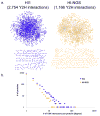Next-generation sequencing to generate interactome datasets
- PMID: 21516116
- PMCID: PMC3188388
- DOI: 10.1038/nmeth.1597
Next-generation sequencing to generate interactome datasets
Abstract
Next-generation sequencing has not been applied to protein-protein interactome network mapping so far because the association between the members of each interacting pair would not be maintained in en masse sequencing. We describe a massively parallel interactome-mapping pipeline, Stitch-seq, that combines PCR stitching with next-generation sequencing and used it to generate a new human interactome dataset. Stitch-seq is applicable to various interaction assays and should help expand interactome network mapping.
Conflict of interest statement
The authors declare no competing financial interest.
Figures




References
-
- Walhout AJ, Vidal M. Methods. 2001;24:297–306. - PubMed
Publication types
MeSH terms
Grants and funding
LinkOut - more resources
Full Text Sources
Other Literature Sources
Molecular Biology Databases
Research Materials

